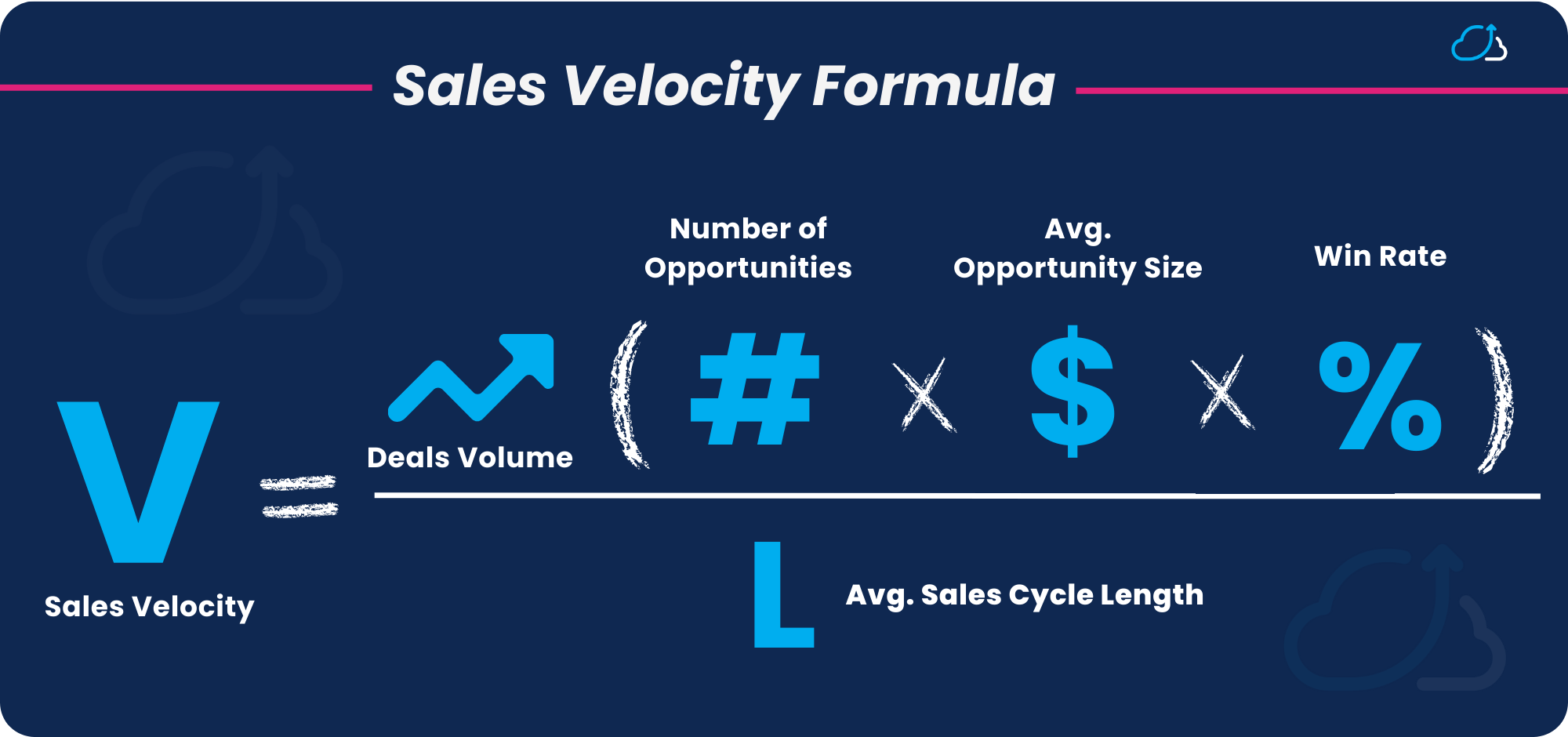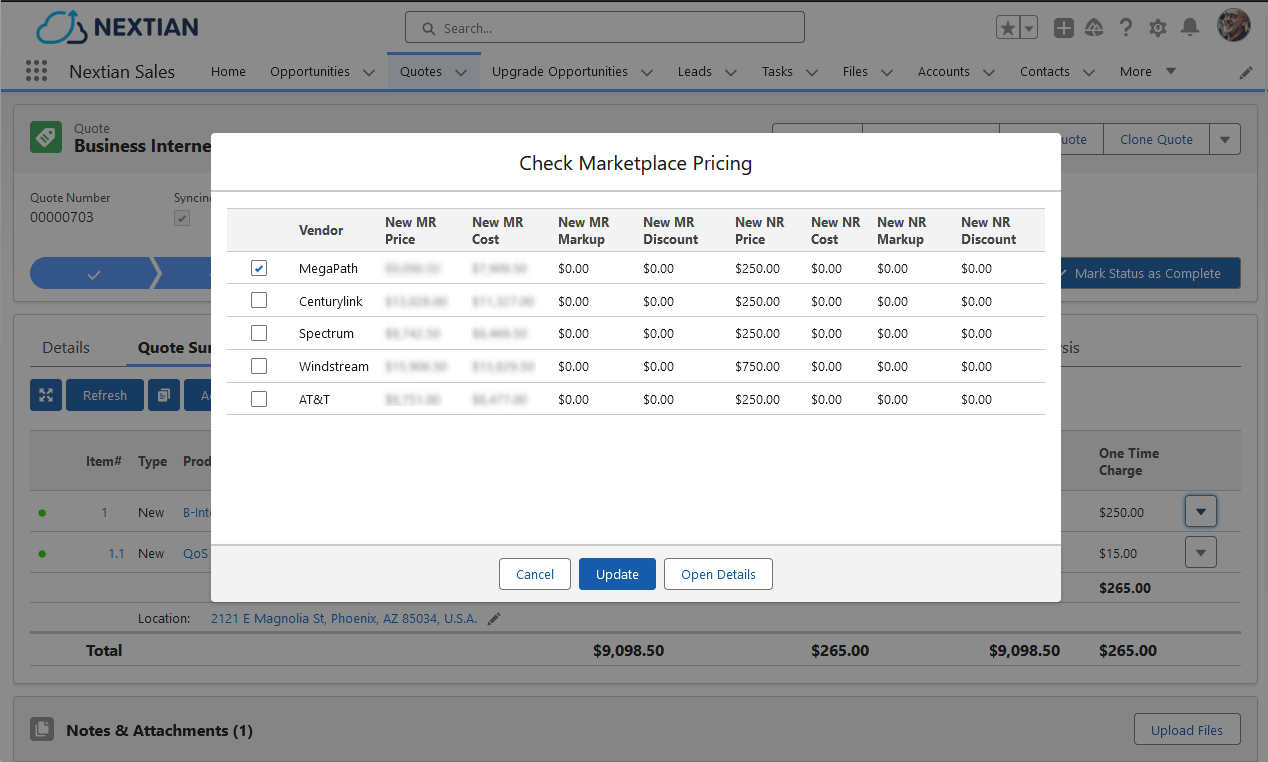Increasing Sales Velocity for Cloud & Communications Services
What Is Sales Velocity?
Sales velocity measures how quickly a business generates revenue, serving as a key indicator within the broader Quote-to-Cash (QTC) cycle
It is typically calculated as the amount of revenue generated over a specific time period, such as dollars per month ($/month). The higher the sales velocity, the more efficient the sales organization is at turning opportunities into closed deals.
While different companies might use variations of this formula, the core of sales velocity revolves around deal value and the length of the sales cycle.
Sales velocity measurements are typically based off a sales pipeline, with drill downs by products, customer segments, new/existing logos, deal sizes, reseller partners and others.
Tracking sales velocity for service modifications, such as adding new features or user licenses to existing services (e.g., expanding SQL database licenses), may require additional data sources beyond the sales pipeline. This is because these service changes may not be tracked as CRM opportunities.
Why Is Sales Velocity Important?
Sales velocity is extremely useful for forecasting and identification of areas where a sales process can be improved to generate more revenue such as: bottlenecks, funnel leaks, rep coaching, etc.
For cloud and communications services (Internet access, bare-metal servers, colocation, SaaS) with various deals including:
- New logo sales,
- Up-selling/service changes,
- Cross-selling/additional services or add-ons.
sales velocity can be measured across the entire pipeline, and typically remains similar regardless of deal type:
- New customer deals typically have long sales cycles but are high value.
- Up-sell and cross-sell deals usually have shorter cycles but lower value.
In both cases, sales velocity remains similar.
Increasing Sales Velocity
Sales velocity can be increased by increasing closed-won deal volumes (expressed in $ amounts) and/or shortening the sales cycle.
Closed-won deal volumes depend on three factors: number of opportunities in the pipeline, individual deal amounts, and win rates. These three factors are interdependent and cannot be treated separately as improving one usually degrades another.

Improving sales velocity is a cross-departmental effort involving product, sales, pre-sales, customer support and others, as well as improvements to software & systems.
Going forward, we will focus on ways to increase sales velocity of cloud & communications services from a software and systems perspective.
Software and Systems Improvements
Nextian quote-to-cash helps improve sales velocity in the following key areas:
Quoting Automation
While quote generation itself is usually not time consuming and many CPQ (Configure Price Quote) packages are available on the market, things tend to hit a speedbump in the following areas:
- Ability to quickly create complex quotes with line items including not only new services, but also changes such as new service add-ons, upgrades, moves and others (these are referred to as MACDs in the telecommunications industry).
- Quote approvals based on discounts, contract volumes, net revenue and profit values for complex transactions such as a purchase of two brand new services, upgrade of an existing one, one cancellation and one move to another location. Such transactions are common for large enterprise and wholesale sales.
- Support of product sourcing from third parties. Some businesses (e.g., Telecom Service Brokers – TSBs or resellers) source products from a variety of vendors which may charge different fees for the same product. In addition, the same product from a single vendor, may have different pricing based on a region (e.g. U.S. vs. EMEA data center) or other factors. Integrating third-party sourcing and pricing with profit and margin calculations and approvals into the CPQ process is usually a significant challenge.
- Easy handling of complex products. Some products such as voice, UCaaS or Wi-Fi access for large office or residential buildings require many components and moving parts tailored to specific user needs and scaling up to hundreds of items on a single quote.
A CPQ supporting all the above features will drive sales velocity by shortening sales cycles.
Other benefits (not related to sales velocity) include increased quote accuracy, improved reporting, tight margin management, unified quote-to-cash process (changes can be processed as opportunities & quotes) and others.

Enable Self-Service Sales Channels for Customers & Partners
Since customers and partners tend to use self-service when they have already made purchase decisions, sales cycles are relatively short for self-service transactions.
The following self-service features help with increasing sales velocity:
- Online e-commerce. For simple services, on-line purchasing (e-commerce) is usually the first feature as far as improving sales velocity is concerned. It is a common approach to offer only select products via e-commerce and exclude complex ones, i.e. ones that require pricing & sourcing from third parties or need a lot of detailed information from customers. E-commerce can also be useful for running sales promotions and SPIFFs.
- Quote desk. Complex products are better handled on-line via quote desks. Rather than add to cart and buy, users request a quote, the quote is prepared by the back-office and returned in the portal for user approval. This gives pricing teams the opportunity to adjust pricing, obtain internal approvals as well as reach out to a customer for additional information. While quote desk sales cycles are longer than e-commerce purchases, the quoted amounts are usually higher, and sales velocity remains high.
- Self-management of product features. These typically include changes to license counts, adding more storage or computing power, larger IP blocks, enabling QoS and others. Manual management of service features is time consuming and revenue gains are relatively small, therefore self-service and automation are a must to keep the sales velocity high.
- Automated renewals. Except for evergreen contracts, cloud & communications providers strive to secure future revenues by renewing existing contracts (rather than keeping them on a month-to-month basis). Automating renewal process via self-service helps securing revenue as well as shortens renewal cycles.
- Partner Portal. The items listed above assume self-service actions performed by customers in a Customer Portal. For businesses that rely on partners/resellers it may be beneficial to enable self-service for partners as well. While partner and customer portals are similar, data security rules must be considered (CPNI for US and GDPR for EU) as well as partner pricing and commissions.
Customer and partner self-service drives sales velocity as customers and partners usually act when they are ready to buy, which shortens sales cycles. While individual transactions are small, their volume can be significant.
Other benefits (unrelated to sales velocity) include increased efficiency of the sales team (measured as $ amount produced per headcount).
Automated Discovery of Upgrade Opportunities
Timing is one of the major issues with accelerating up-sales and cross-sales for existing customers: too often sales reps rely on customers to initiate the conversation rather than reach out proactively. On the other hand, it is difficult to be proactive when service usage information is only available to the technical teams not to sales or account managers.
The following can accelerate sales velocity for up-sales and cross-sales:
- Enable a 360° view of customer services’ status & usage in CRM. Providing basic service information like status, availability, usage (CPU, storage, bandwidth, etc.), key outages & alarms keeps sales reps and account managers informed and enables them to make better decisions.
- Automatically create upgrade opportunities in CRM. While information about service status and performance is certainly useful, it is not actionable. Applying analytics and converting this information into upgrade opportunities kicking off the sales process, will drive sales velocity up.
- Enable forward looking analytics. When an issue arises (such as exhausted storage on a SQL database or dedicated server hard drive), it is usually too late, and the service has already been degraded. Even worse, the degradation might be present for a long time and a customer may already be looking for a different vendor. Therefore, it is important to have forward-looking analytics, i.e. the storage will reach 80% usage in three months’ time.
- Enable partners to do the sales. Upgrade opportunities can not only be used internally, but also made available in the Partner Portal to resellers (limited to services sold by individual partners). This not only helps with sales velocity (partners can usually reach out to customers and close deals quicker) but also overall sales efficiency because it scales better.
All the items above help with significant shortening of up-sell and cross-sell cycles as sales reps can reach out to customers at the right time of the sales cycle (i.e., when a need has been identified). The deals have smaller value; however, their volume can make up for it.
Other benefits (unrelated to sales velocity) include increased efficiency of the sales team (measured as $ amount produced per headcount) as well as finding missing revenues and churn prevention.

Increasing Sales Velocity with Nextian
Nextian is a vendor of Quote-to-Cash (QTC) software for cloud and communications helping providers accelerate growth and increase customer lifetime value (LTV).
Increasing sales velocity is an important factor for revenue and LTV growth and Nextian QTC modules have been designed with that in mind:
| Module | Features driving sales velocity |
|---|---|
| CPQ & Sales |
|
| CRM-to-Network Monitoring Integration |
|
| Customer Portal |
|
| Partner Portal |
|
| Reporting & Analytics |
|
Conclusions
Sales velocity measures how quickly revenue is generated and flows through the sales pipeline. Boosting sales velocity can be achieved by increasing deal volumes (increase average opportunity size, increase win rate, more opportunities) as well as shortening the average sales cycle.
Nextian offers products and services that help cloud and communications providers streamline their Quote-to-Cash processes and increase sales velocity, driving revenue growth and customer retention.
Contact us today to find out how we can help you!






